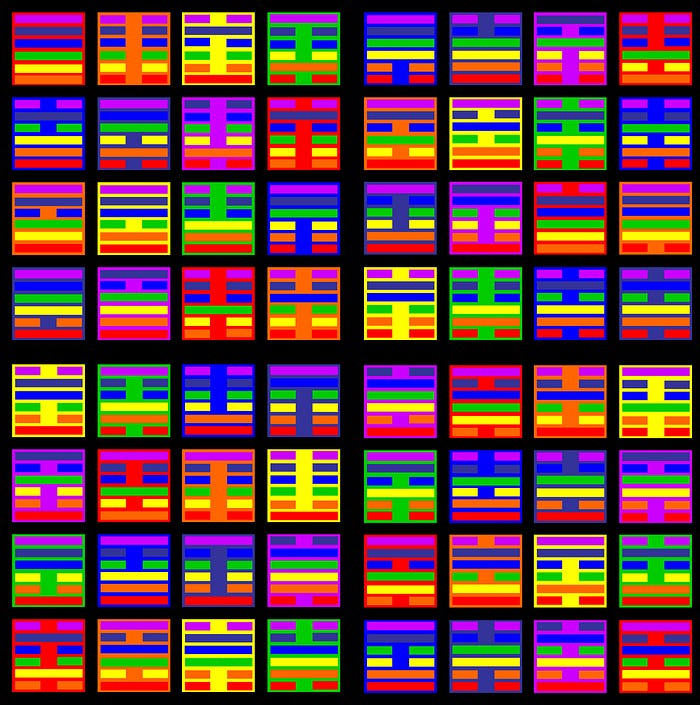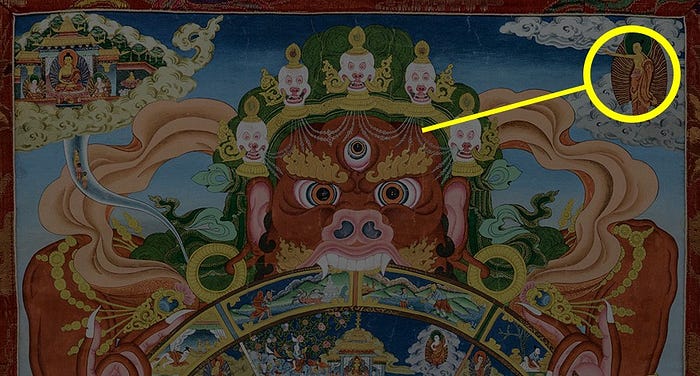
“They have their exits and their entrances, and one man in his time plays many parts.”
I. THE OLD RELIGIONS OF THE YOUTHS AND THE NEW
Hip-hop has always been innovative in music, fashion, and lifestyle. In 2017, a more radical innovation met great controversy: the creation of a new religion. A prevalent phenomenon among a younger generation of hip-hop emcees is the wearing of upside-down crosses and other symbols that some believe to be signs of devil-worship. Upset at this fashion, one well-known rapper with Christian beliefs named Offset, of the popular trio Migos, reprimanded some of these so-called devil-worshippers, sparking a media and philosophical battle between these two factions of hip-hop.
“All y’all n*ggas wearing upside down crosses, even my little partners, stop that sh*t. You look lame,” Offset said. “All that worship the devil sh*t. Get with God man.” — Offset
In protest of these accusations, an emcee from the other sect named SahBabii claimed that his donning of upside-down crosses and the number 666 did not refer to devil-worship at all. Instead, he claimed these signs represented what he called “Unknownism,” an “ideology for seeking the truth.” Unknownism was a self-created “religion” by SahBabii which accepts “the fact of not knowing if all this bullshit they tell us is true.” The sign of 666 which SahBabii uses represents 6 protons, 6 electrons and 6 neutrons of the melanin of the skin. He was proud of being black, he claimed. This imaginative argument was harshly rebuked by the African-American, Christian community for numerous reasons.

In SahBabii’s defense, what he actually intended to do with his actions was transmute these “evil,” “devil-worship” signs into new meanings. The sign of the cross as the symbol of Christian faith was only an invention introduced centuries after Christ’s death by the Roman emperor Constantine. Of course, in a black community where Christianity has strong roots, these signs had too much history to easily be embraced without the baggage of their existing meanings thereafter. SahBabii’s failure wasn’t a failure of inquiry or the succumbing to the devil but of the ability to conquer signs that were too crystalized and abhorred in the Christian mythos of this era. Considering the deep roots of the Christian gospel from the time of African-American slavery, SahBabii’s gesture to break away from this history was a radical one but one that did not succeed in the eyes of spectators and the media. Instead, it resurrected age-old battles between good and evil. At root, however, SahBabii’s ideology of “not knowing” and questioning the faith in which these youths were indoctrinated isn’t exactly controversial. This instinct is quite common in scientists and believers alike. Skepticism and doubt — not blind faith — has always helped humankind to progress, even in the history of religions, the democratization of Christianity from Catholicism to Protestantism being one example. If this is true, why was SahBabii’s claims met with such scrutiny? Is it that science and history had not done enough to vindicate such inquiries? Certain segments of society, it seems, have a difficult time divorcing well-accepted signs from the narratives they have created around them. The cost would be too great.
***
II. THE FAILURE OF SCIENCE
“Perhaps, now, physicists can only be mere philosophers.”
“Ever since the dawn of civilization,” Stephen Hawking wrote in his international bestseller A Brief History of Time, “people have not been content to see events as unconnected and inexplicable. They have craved an understanding of the underlying order in the world.”
Galileo’s observation that the earth rotated around the sun became a threat to the power of the Catholic church which believed such a model of the universe would usurp the earth-centric narrative interpreted from the Bible in which the church maintained its power. Galileo was eventually placed in a type of house arrest for his blasphemous claims. He knew that he would be executed if he spoke out further. As Galileo saw the sun cast a shadow on the floor, he famously uttered to himself the words “Eppur si muove,” or “And yet it moves.”
Today, Galileo’s observations are commonly known as fact. It is our massive sun in the center that keeps our solar system in order. Along with many other factors, Earth’s distance from the sun is at the proper distance for life-sustaining conditions, a seemingly rare cosmic occurrence. As the Age of Enlightenment brought about many new, factual and falsifiable observations, scientific thought created an explosion of understanding of the universe and the ways man could utilize such knowledge through scientific inquiry, method, and production. From this era, the church and its falsifiable explanations of the universe slowly gave way to the rise of more secular and democratic societies. Galileo’s theories were vindicated.
This idealism that science would eventually answer all the mysteries of the universe stayed true until the discovery of the Higgs boson, or the “God Particle” as sensationalized by the media. As the elementary and fundamental particle that all existence is based on, the Higgs did not have a mass, or energy level, that fit within the models of our greatest, long-standing, and seemingly infallible scientific observations. Something was missing from the scientific models we had built up over the centuries. Surprisingly, the mass of the Higgs pointed to the fact that we live in a multiverse — our universe was just one universe outside of a potentially infinite amount of universes. We would never find the underlying order to our universe now because we could never reach outside of our own universe. This multiverse meant that our ability to understand the universe was inherently limited. The elusive “theory of everything” would forever be outside our ability to discover. Discouraged, the physicist David Kaplan admitted that this new discovery could mean the “end of physics” or the end of our reach of scientific inquiry and discovery. All our scientific equations, descriptions, and theories had to be slightly wrong or incomplete. For all we know, our universe could be suspended by turtles and turtles all the way down. This was the end of the Age of Enlightenment: the pursuit of science finally conquering all the most fundamental questions of our existence was now impossible. Like Sahbabii’s ideology of “Unknownism,” we do not know if all our scientific theories and models are completely true. Yet, some believe to know what lies beyond our universe: the underlying, unknowable order.
***
III. WHITE SUPREMACY AS EPIC THEATRE

“They called him Mr. Glass.”
Despite the efforts of scientists, unreliable thought still flourishes. Richard Spencer, president of the National Policy Institute, a white supremacist think tank, and so-called leader of a new generation of neo-Nazis, has supported polytheist religions as legitimate mythos by which white supremacists could believe and practice, harkening back to “white” culture and values in the form of ancient Norse or Viking mythology, a bellicose set of beliefs in sharp contrast to Judeo-Christianity, which Spencer believes to be the values of the weak — values which he claims have led to white people losing their rightful place in the world as the superior, dominant race or culture. It seems
A little known fact of Richard Spencer is that he was once an aspiring theater playwright whose greatest influence was the great German playwright Bertolt Brecht. Brecht’s philosophy of “Epic Theatre” utilized the effect of Verfremdungseffekt, or alienation, as a means to expose the construction or artifice of the play itself. Brecht believed that having viewers “fall into” the narrative of a play as in most traditional stories was a form of escapism and did not fulfill the realistic political function of art. In relationship to Spencer’s fascist beliefs, ironically, Brecht’s themes were based on Marxist thought, and Brecht, in opposition to the Nazi party, escaped Germany during World War II. Although Spencer no longer writes plays, his art continues in the creation of a new mythos of white supremacy. Today’s white supremacist youth are, in actuality, characters in Richard Spencer’s real-life play. Using one of Brecht’s strategies of alienation, Spencer has broken the 4th wall and taken his theater to the streets. However, this time, not many have seen the artifice of its fabrication. They believe Richard Spencer to be a real white supremacist instead of the director, writer, and protagonist of its drama playing out in the real world. Do not be fooled.
***
IV. RUSSIAN SALVATION
“Donald Trump is a prophet?”
proph·et /ˈpräfət/ (noun)
1. a person regarded as an inspired teacher or proclaimer of the will of God.
A well-known tactic of the Russian propaganda apparatus during the 2016 American elections was the use of social media outlets masquerading as Christian religious groups. To play into the mythos of Christian Americans who are demographically more likely to be Republican, Russian agents attempted to sway the results of the election in favor of Donald Trump.
If any of these folks found their salvation through these lies, would their salvation be any less real — or just as fabricated?

***
V. MATHEMATICS AS LANGUAGE OF THE DIVINE
“There are no two equal things in the universe: the problem with math.”
In all cases, purely through a mathematical perspective, we can see what all these ideologies represent:
c = constant, g = god, w = white power

Throughout time, humankind has placed a great symbol in the place of what was unknown. Sometimes, this has been scientific truth, God, polytheist gods, or simply the pride of being white. All these placeholders give humans meaning, a foundation to move forward with confidence in the great mystery of life: a goal.
Furthermore, what is true is that these descriptions and ideologies of these placeholders change over time. Then, these placeholders are not constants at all but variables (x).
All ≈ x
It seems the x will be an unknown forever, particularly due to the findings of the multiverse. It seems that now even science will have to find satisfaction in the unknown. Unknownism, then, rings true. But we’ve been here before.
***
VI. THE VALUE OF ESTABLISHED SCHOOLS OF THOUGHT
Despite one’s beliefs, the Abrahamic religions, Buddhist practice, and other sciences have had centuries or millennia to debate over philosophical questions. Many arguments have been made and much blood has been spilled in this pursuit of truth. The question for SahBabii is “will he be a martyr or a saint (or something in-between)?
“The destruction of ideals, the new desert; new arts by means of which we can endure it, we amphibians.”
***
VII. THE REINCARNATION SOLUTION

“Live life once or over and over again.”
What lies beyond our universe is more universe. In Buddhist thought and cosmology, there is no need to play these games of truths and unknowns. Thousands of years ago, Buddhist observations “predicted” the discoveries of today, even when compared with scientific discovery. Recent evidence has suggested that the Big Bang that began our universe has happened multiple times. Universes like ours happen for all eternity, it can be presumed. If this is so, in an infinite amount of possibilities that happen over and over again, this same exact universe with the same exact possibilities, peoples, and actions –– even the act of someone reading this very sentence –– will eventually happen again and again as a type of eternal return as described in Buddhist cosmology or reincarnation. There is nothing beyond these universes. The concept of reincarnation is to keep humankind here in this world. If we keep coming back, humans can only be more humane to other living beings and not long for another realm beyond their own –– this is Materialism at its core.
Reincarnation, however, in terms of being born again into a new organism, seems quite unlikely and even undesirable. What seems very likely, however, is that this universe can be born again and again — somewhere else eventually. But how would we ever know? The material reality of our existence, then, in the things we can see, touch, smell, hear, and taste is all there is to know: natural law. There is no beyond worth our time. The joy with and responsibility to other living beings and the conditions of this universe are the prizes that we seek –– the eternal sunshine of the spotless mind.
***
VIII. THE YUNG BUDDHA SPEAKS
“We are the ones we have been waiting for. Now, what to do?”
In the gauntlet of belief systems — between two imaginary infinities where a pulsar spins, its gravity disintegrating all in its path, at all ends of the universes coalescing all matter to a point so dense it begins again, without losses or expenses, emitting rotating wavelengths of sound — see the light: the creation of a proper universe — the NuZen.
Unknownism by SahBabii


